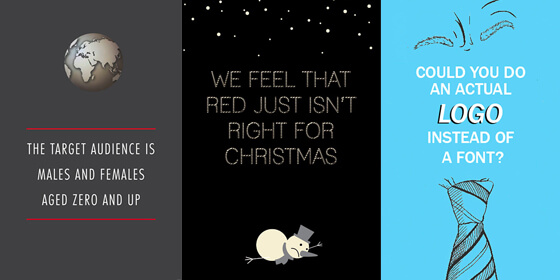4 Tips for Effective Feedback in Web Design
I recently came across a series of posters inspired by some of the most frustrating feedback designers across the globe have received from clients. Whilst they provided me with a good 5 minutes of amusement, I was all too aware of how familiar some of these comments were. Comments such as, “Can you just jazz it up a little?”, “I’m the target market, and I don’t like it”, and my all time favourite: “I’ll know it when I see it”. *facepalm*
As Project Manager, I know all too well that the design phase can be tricky to navigate, and this can often be where a project gets held up.
The key to developing a great design, and keeping a project moving along, is clear communication and collaboration with the client. The client is the expert on their product or service, and probably has a good idea of how they want it to be portrayed. You, the creative, are the expert in designing amazing web experiences. In an ideal world you would both speak the same language, work off incredibly effective feedback and it would just be plain sailing to the finish line. In an ideal world.
The reality is that getting tangible feedback isn’t an easy feat, whether from a client or even a member of your own team. Often there are several stakeholders involved in a project with different objectives. Feedback can be vague, indecisiveness can reign and subjectivity can weigh down the entire process. Whilst design is of course subjective by definition, having a few simple guidelines in place will help to ensure that you get effective feedback from your clients and make the process as smooth as possible.
1. MANAGE STAKEHOLDERS
When there are multiple stakeholders involved in a project, as is quite often the case, it can be difficult to get decisive feedback. It could be that Person A and Person B will always rely on Person C’s opinion before giving theirs. Or perhaps Person D and Person E have conflicting objectives. Maybe Person A has had a bad experience with a design agency in the past, and therefore has come to the table with a wary approach.
Whatever the issue, the first step is to establish early on who the ‘working group’ will be and who among them will have ultimate control over the sign-off process. It’s important to create an honest and open environment throughout the project as this will encourage effective communication. Remind stakeholders that you are a team with a common goal. This will help to get everyone behind the vision and dispel any feelings of wariness or negativity.
It’s important to create an honest and open environment throughout the project as this will encourage effective communication.
2. AVOID AMBIGUITY
Vague descriptors like “jazzy”, “edgy” or “slick” aren’t exactly tangible, and can be easily open to misinterpretation. “I like it” or “I don’t like it” doesn’t quite cut it either. Whilst your client is best placed to advise on how they want their business to be perceived, they aren’t design professionals and don’t always have the language to describe what they want. So, simply asking them to be more specific may not be the most effective approach. Instead, ask them “why?” and keep asking “why?” until you can understand what it is they are really trying to achieve.
Another useful approach is to ask them to show similar examples to what they mean. This is a great way to help them visualise their thoughts and make sure you’re both on the same page.
ask them “why?” and keep asking “why?” until you can understand what it is they are really trying to achieve.
3. KEEP IT BALANCED
As humans we have a tendency to focus on the negatives, but understanding what your client does like about a design is just as important as understanding what they don’t. Make sure you take the time to ask what they like and why, as this will help inform the design development just as much as the dislikes. Plus, positive comments help reduce the negative impact of any criticism. Bonus.
understanding what your client does like about a design is just as important as understanding what they don’t.
4. DON’T TAKE IT PERSONALLY
You’ve asked all the questions, you think you’ve got the right idea about what your client is after, you’ve spent a week putting together a design and…they don’t like it.
It can be challenging not to take offence when your designs are criticised, and all too easy to blame the client for not communicating their desires effectively, but don’t. Criticism goes hand in hand with the design process and, if managed correctly, the resulting feedback will be instrumental in achieving a solution that both you and your client are happy with.
ACCEPT THAT Criticism goes hand in hand with the design process.
Receiving feedback is valuable, but can be difficult to manage. Hopefully the above four tips will not only help the design phase of your projects run smoothly, but will result in happy clients and fulfilling projects!













